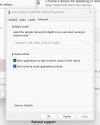OakHillChurch
New Member
We upgraded our sound system at church where we now use OBS for streaming. 3 weeks in a row we have had audio issues with it crackling, popping then eventually cuts out all together. I have read that this is a common issue and we need to change the sample rate to 44.1. I have changed it in OBS but in the Windows Sound Settings I cannot change it. It seems to be locked at 48. I attached a screenshot. You can see it menu is not dark. Anyone have an idea on how to fix it? I have been doing sound for 30 years, video for 15 years. I have never been so close to quitting than I am now. We don't record our streams so I'm not sure if I can provide a stream log. I am hoping to fix it with the sample rate settings. If not I will find a way to provide a stream log on here. Thanks guys.
